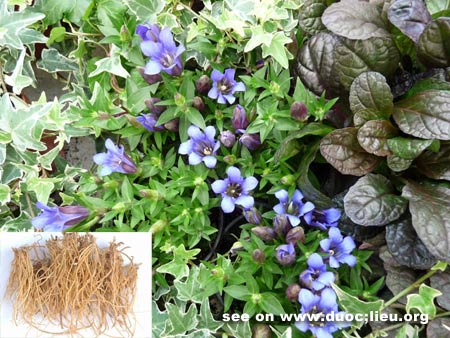Pharmaceutical Name: Radix Gentianae
Botanical Name: 1. Gentiana scabra Bge.; 2. Gentiana triflora Pall.; 3 Gentiana manshurica Kitag.
Common Name: Chinese gentian
Source of Earliest Record: Shennong Bencao Jing
Part Used & Method for Pharmaceutical Preparations: The roots, or rhizomes, are gathered in autumn, dried in the sun and cut into pieces.
Properties & Taste: Bitter and cold
Meridians: Liver, gall bladder and stomach
Functions: 1. To clear heat and dry dampness; 2. To reduce fire in the liver
Indications & Combinations:
1. Damp-heat syndrome: a) damp-heat jaundiceChinese gentian (Longdancao) is used with Oriental wormwood (Yinchenhao) and Capejasmine (Zhizi); b) damp-heat leukorrhea manifested as pain and swelling in the genitals and eczemaChinese gentian (Longdancao) is used with Phellodendron bark (Huangbai), Flavescent sophora root (Kushen) and Plantain seed (Cheqianzi).
2. Upward attack of liver fire manifested as headache, distending sensation in the head, red eyes, deafness and pain in the
costal regions. Chinese gentian (Longdancao) is used with Scutellaria root (Huangqin), Capejasmine (Zhizi), Bupleurum root (Chaihu) and Clematis stem (Mutong).
3. Fever, spasms and convulsions. Chinese gentian (Longdancao) is used with Uncaria stem (Gouteng) and Ox gallstone (Niuhuang).
Dosage: 3-10 g.
Cautions & Contraindications: This herb is contraindicated in cases with weakness and cold in the spleen and stomach.

